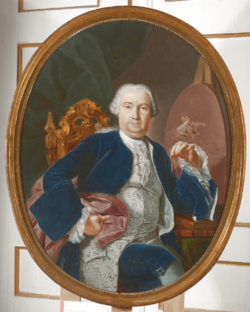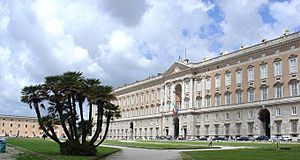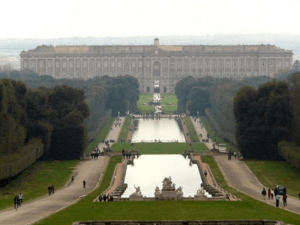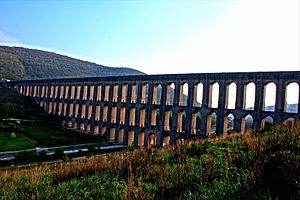Luigi Vanvitelli facts for kids
Quick facts for kids
Luigi Vanvitelli
|
|
|---|---|

Luigi Vanvitelli in a portrait by Giacinto Diano (1765)
|
|
| Born | 12 May 1700 Naples, Kingdom of Naples
|
| Died | 1 March 1773 (aged 72) Caserta, Kingdom of Naples
|
| Nationality | Italian |
| Known for | Architecture, painting |
|
Notable work
|
Palace of Caserta and Royal Palace of Naples |
| Movement | Baroque and Neoclassicism |
Luigi Vanvitelli (Italian pronunciation: [luˈiːdʒi vaɱviˈtɛlli]; 12 May 1700 – 1 March 1773) was a famous Italian architect and painter. He was known in Dutch as Lodewijk van Wittel. Luigi Vanvitelli is considered one of the most important architects in Italy during the 1700s. His building style was a mix of the grand and detailed Baroque style and the simpler, more classic Neoclassicism.
Contents
Luigi Vanvitelli's Early Life and Training
Luigi Vanvitelli was born in Naples. His mother was Italian, and his father, Caspar van Wittel, was a Dutch painter who created beautiful pictures of landscapes and cities. His father also used the name Vanvitelli.
Luigi learned how to be an architect in Rome. He trained with a famous architect named Nicola Salvi. They worked together on building the well-known Trevi Fountain.
Important Projects and Recognition
Luigi became very famous after he won design competitions. He designed the front of the Basilica di San Giovanni in Laterano church in 1732. He also designed the front of Palazzo Poli, which is the building behind the Trevi Fountain.
Because of his great talent, Pope Clement XII asked him to work on several projects in a region called Marche. In 1732, in the city of Ancona, Luigi designed a huge, five-sided building called the Lazaretto. This building was more than 20,000 square meters in size. It was built to protect the city from diseases that might arrive on ships. Later, it was also used as a military hospital or as barracks for soldiers.
In Rome, Luigi Vanvitelli helped to fix the dome of St. Peter's Basilica when it started to crack. He also found time to paint beautiful pictures on the walls of a chapel in Sant Cecilia in Trastevere. He also built a bridge over the Calore Irpino river in Benevento.
From 1742, Vanvitelli worked with Nicola Salvi again. They designed the Chapel of St. John the Baptist for King John V of Portugal. This chapel was first built in Rome. Then, in 1747, it was taken apart and shipped to Lisbon, Portugal. There, it was put back together in the Church of St. Roch (Igreja de São Roque). The chapel was finished in 1750. It was made with many precious marbles, expensive stones, and gold-plated bronze. At the time, it was thought to be the most expensive chapel in Europe.
The Royal Palace of Caserta
Luigi Vanvitelli was very skilled in engineering and creating dramatic designs. Because of this, Charles VII of Naples (who later became King Charles III of Spain) asked him to design a magnificent new palace. This palace was the grand Palace of Caserta. King Charles wanted a palace that would be as grand as the Palace of Versailles in France. He asked Vanvitelli to create the most beautiful palace in Europe. The Palace of Caserta is the largest royal palace in the world by volume, meaning it has the most space inside.
As part of the Royal Palace of Caserta, Vanvitelli also designed a unique vineyard called the Vigna del Ventaglio. This vineyard was planted on a sloping hill near the palace. It was shaped like a fan, divided into 10 sections. Each section had a different type of grape vine. Some of the grape types planted there included local varieties like Pallagrello bianco and Pallagrello nero.
Luigi Vanvitelli worked on the Caserta project for the rest of his life. He worked for King Charles and then for his son, Ferdinand IV. In Naples, he also added to the city's royal palace in 1753. He designed some grand homes for wealthy families and churches, like the new church and monastery for the Missione ai Vergini.
His engineering skills were also used for Caserta. He designed a huge water system called the Aqueduct of Vanvitelli. This aqueduct brought water to power the beautiful waterfalls and fountains at the palace.
Luigi Vanvitelli passed away in Caserta in 1773.
See also
 In Spanish: Luigi Vanvitelli para niños
In Spanish: Luigi Vanvitelli para niños





